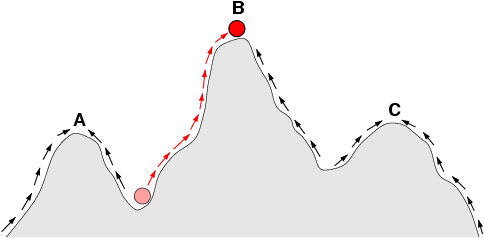Courage and wisdom are core values everywhere.
These values are so familiar as to be universally seen as perquisites of the
human condition, but they aren’t that automatic at all. There is nothing in the
genes of the human animal to predict that these values will occur in human societies
everywhere, as naturally as walking on two feet does. Bipedal
motion arises almost automatically out of our genetic design. But values like respecting
elders, for example, don't. Certain values are found in nations all over the world
because they work—they enable a human society to survive and flourish. That is
convergence in social evolution. Other concepts in the biological sciences also
apply in analogous ways.

2 dimensional graphic of fitness landscape concept (credit: Wikimedia Commons)
(In the environment which this graphic portrays, "B" is the species most fit to survive.)

3 dimensional graphic of fitness landscape concept (credit: Wikimedia Commons)
(Note: In a "rugged" environment, multitudes of species compete ruthlessly to survive.)
One of the subtlest of these concepts
is modelled in what evolutionary biologists call a fitness landscape, which is the model from which the concept of cultural
convergence derives.1 If we draw a graph showing how two genetic
traits, say size and colouring, interact to give a size-colour survival index
for a given species in a given environment, we can find the place on the graph
where the two traits combine to provide the optimal survival chances for that
species in that environment. Next, we can plot a similar graph but in three
dimensions, with an x axis, a y axis, and a z axis as we learned to do in high school math class. The resulting
picture in three dimensions would show a theoretical landscape with ridges and
peaks and valleys. The peaks indicate where the best combination of colouring,
size, and, let’s say, coat density lie for that species’ survival in our
three-dimensional graph’s environment.
Geneticists speak of fitness landscapes of ten,
fifty, and two hundred dimensions as if what they are talking about is completely
clear. No graph of any such landscape could be pictured by the human mind, of
course, but with the mathematical models we have now and with computers to do
the calculations, geneticists can usually predict what niches in an emerging
environment will contain which kinds of species and how long it will take for
the species in that ecosystem to settle into balance.
The concept of a fitness landscape—one that exists
only in imaginary, mathematical space—can then be applied to the combinations
of memes in human cultures, combinations that produce morés and patterns of
behaviour in the real people living real lives. The concept of a meme—a basic
unit of human thinking—is a tenuous one, and it is still considered by some
social scientists to be unproven and of uncertain value. (see Richard Dawkins’s
“Selfish Genes and Selfish Memes,” chapter 10 in Hofstadter and Dennett’s The Mind’s I for a basic explanation of
the meme concept.2) But for now, if we take it as a given, the
results of the thinking enabled by the meme concept support what this book is
trying to show.
We can construct, in imaginary, mathematical space,
a fitness landscape for memes—in other words, for unit-ideas—that humans use to
build up systems of beliefs about what the universe is made of and what forces
and fields give direction to the movements of the things in it. Those things include
us, the thinking things, and what we can and should be doing in this mix. That
fitness landscape, that multi-dimensional graph of human thought patterns, will
be very similar for all individuals in a given culture. What I mean by red and round and sweet and tangy is pretty close to what other
English speakers mean by these terms. So is what I mean by the terms apple or plum. My idea of beauty roughly coincides with other
Canadians’ ideas of beauty. Even our definitions of terms like good, wise, and democracy
largely coincide. They enable us to communicate effectively and live in communities most of the time. I
am a son of my culture.
No comments:
Post a Comment
What are your thoughts now? Comment and I will reply. I promise.